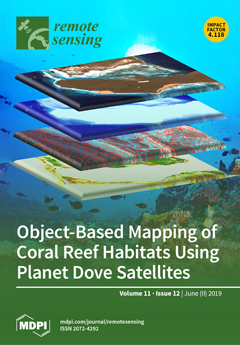Spatially continuous estimates of forest aboveground biomass (AGB) are essential to supporting the sustainable management of forest ecosystems and providing invaluable information for quantifying and monitoring terrestrial carbon stocks. The launch of the Ice, Cloud, and land Elevation Satellite-2 (ICESat-2) on September 15th,
[...] Read more.
Spatially continuous estimates of forest aboveground biomass (AGB) are essential to supporting the sustainable management of forest ecosystems and providing invaluable information for quantifying and monitoring terrestrial carbon stocks. The launch of the Ice, Cloud, and land Elevation Satellite-2 (ICESat-2) on September 15th, 2018 offers an unparalleled opportunity to assess AGB at large scales using along-track samples that will be provided during its three-year mission. The main goal of this study was to investigate deep learning (DL) neural networks for mapping AGB with ICESat-2, using simulated photon-counting lidar (PCL)-estimated AGB for daytime, nighttime, and no noise scenarios, Landsat imagery, canopy cover, and land cover maps. The study was carried out in Sam Houston National Forest located in south-east Texas, using a simulated PCL-estimated AGB along two years of planned ICESat-2 profiles. The primary tasks were to investigate and determine neural network architecture, examine the hyper-parameter settings, and subsequently generate wall-to-wall AGB maps. A first set of models were developed using vegetation indices calculated from single-date Landsat imagery, canopy cover, and land cover, and a second set of models were generated using metrics from one year of Landsat imagery with canopy cover and land cover maps. To compare the effectiveness of final models, comparisons with Random Forests (RF) models were made. The deep neural network (DNN) models achieved R
2 values of 0.42, 0.49, and 0.50 for the daytime, nighttime, and no noise scenarios respectively. With the extended dataset containing metrics calculated from Landsat images acquired on different dates, substantial improvements in model performance for all data scenarios were noted. The R
2 values increased to 0.64, 0.66, and 0.67 for the daytime, nighttime, and no noise scenarios. Comparisons with Random forest (RF) prediction models highlighted similar results, with the same R
2 and root mean square error (RMSE) range (15–16 Mg/ha) for daytime and nighttime scenarios. Findings suggest that there is potential for mapping AGB using a combinatory approach with ICESat-2 and Landsat-derived products with DL.
Full article





